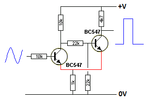supak111
Newbie level 4
Hey guys I'm trying to turn on a BJT cleanly and fully in my light activated circuit. I use an LDR right now so the turn on time for my BJT is slow and I'm not even sure it it ever turns the BJT fully. I was wondering if I replace the LDR with a photo transistor would that have a better turn ON/OFF time?
My circuit is being activated from a very powerful 1/2watt LED light pointing right at the now LDR, there is almost no external light present and the 1/2 watt LED turns digitally so its a clean ON.
If a phototransistor wouldn't help, is there any other way to improve the circuit easily/cheaply to achieve a fast clean ON?
Here is my circuit right now:

My circuit is being activated from a very powerful 1/2watt LED light pointing right at the now LDR, there is almost no external light present and the 1/2 watt LED turns digitally so its a clean ON.
If a phototransistor wouldn't help, is there any other way to improve the circuit easily/cheaply to achieve a fast clean ON?
Here is my circuit right now:

